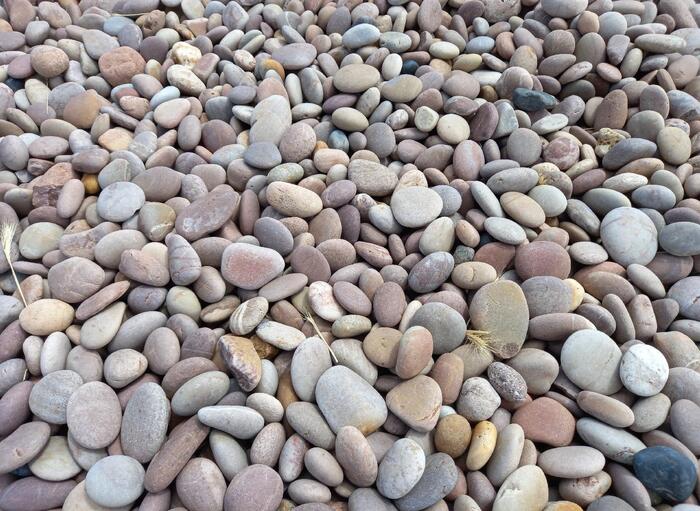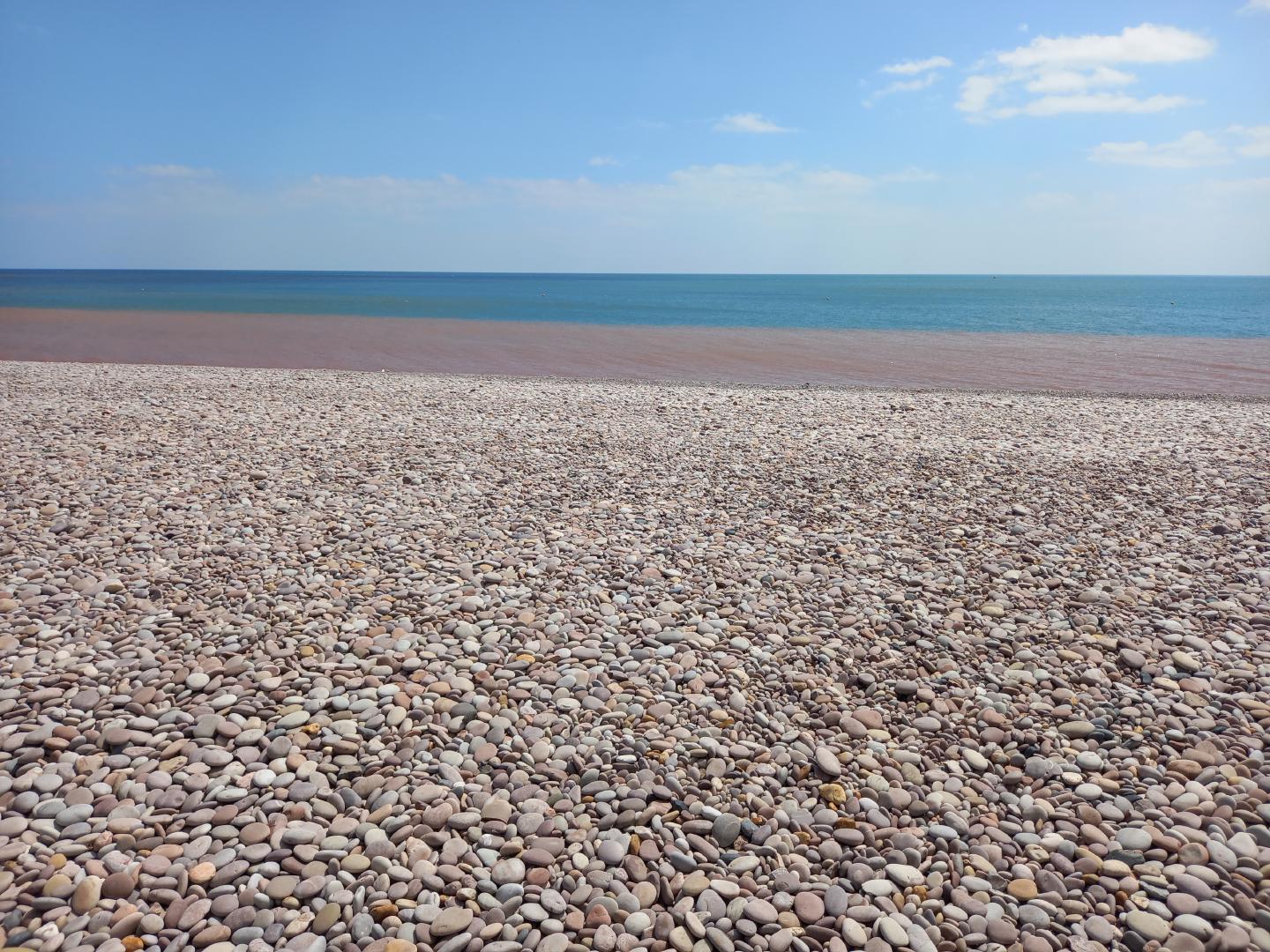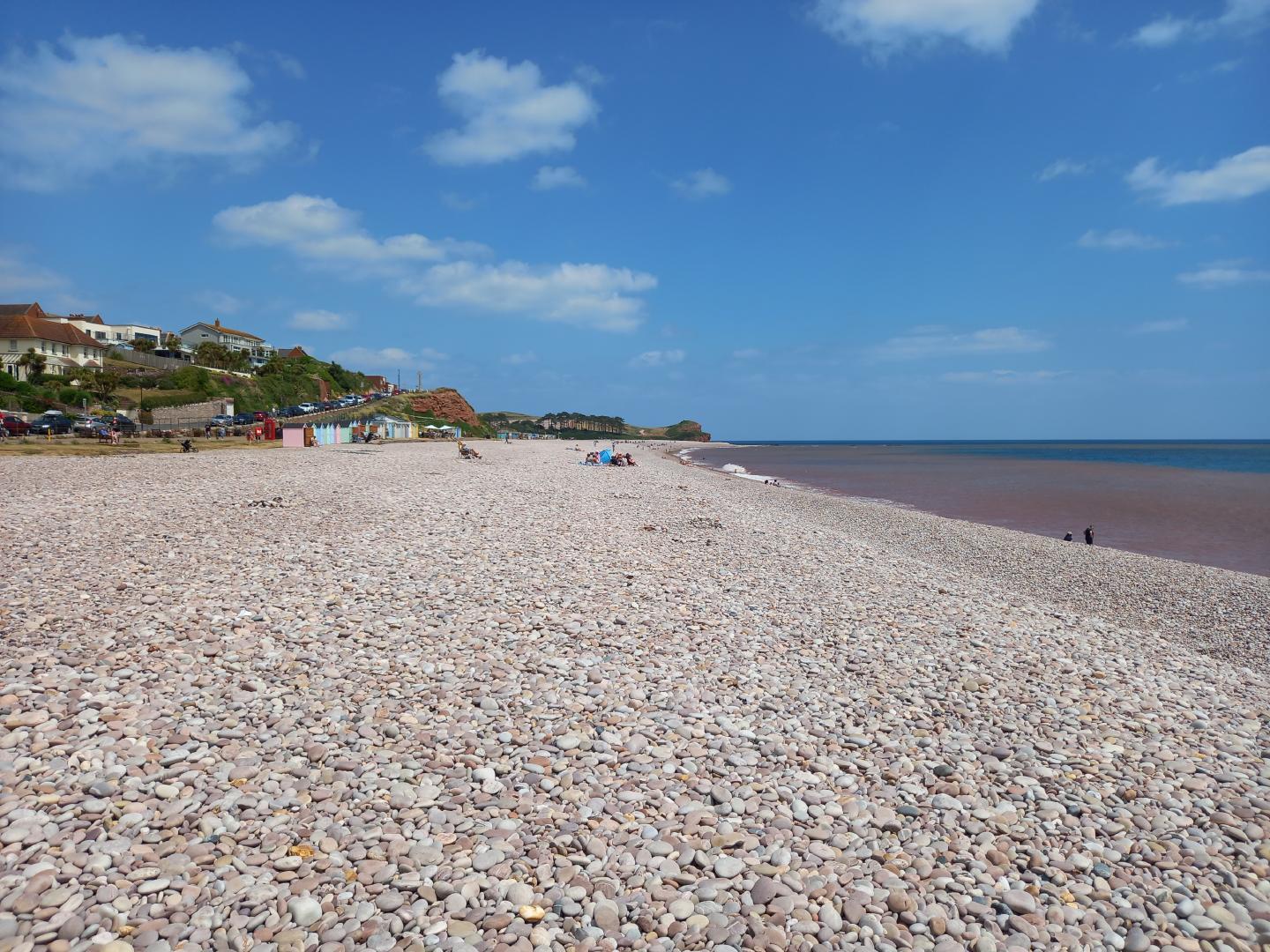4 Likes
5 Comments
We had a #cycletrip to #BudleighSalterton today, which is a nice round trip of 48 km. It was a very pleasant day, not too hot and with a refreshing breeze to keep you cool. Those of you in the know will be glad that I wore short trousers and so my pump could not get stuck in my trouser leg.
The #beach is made up of pebbles of various sizes ranging from the size of your hand (15-20 cm) down to less than a centimetre. The colours vary from #purple and #pink to #grey and #blue. Here's a typical assortment.

Looking out to #sea (the #EnglishChannel), you can see that the water is various colours too ranging from marine #blue and #green to #brown near the #shore where #sediment gets churned up. (Note, it is nothing to do with the current notorious practices of private water companies.)

Looking #west and #east respectively, you can see the #sandstone and #mudstone #geology of the #cliffs


Right up by the #sea, you can sea the small #waves lapping the #shore. I suppose this #photograph is technically a #selfie.

Finally, on the way home, I took a picture of the #cyclepath between BudleighSalterton and #Exmouth which stretches about 6 km and avoids motor traffic altogether. I can't think of many more pleasant routes to #cycle on.

#MyWork #MyPhoto #CCBYSA #Android #Summer #Bike #Biking #Cycling
Interesting stuff. I remember an Arthur C. Clarke story in which the interior of the Earth is completely smooth and featureless just a few miles down because of the pressure... seems that's not the case. More visualisations would help though.
When researchers looked at waves generated by 25 earthquakes, they found they inexplicably slowed down when they reached a jagged patch on the core-mantle boundary. This vast, otherworldly mountain range was highly variable – some peaks stretched 40km (24.8 miles) up into the mantle, equivalent to 4.5 times the height of Everest. Meanwhile, others were just 3km (1.7 miles) high.
Since then, similar mountains have been found lurking at scattered locations all around the core. Some are particularly large: one monster specimen occupies a patch 910km (565 miles) across under Hawaii.
Yet to this day, no one knows how they got there, or what they're made of.
https://www.bbc.com/future/article/20230605-the-hidden-mountains-lurking-deep-within-our-planet
There's a Weird Deformation in Earth's Crust, And We May Finally Know Why
https://www.sciencealert.com/theres-a-weird-deformation-in-earths-crust-and-we-may-finally-know-why
#geology
now a course which even I do understand ;)
GREAT :)
https://vid.puffyan.us/watch?v=fgnvKVzZZes&list=PLcI_lGDDt5A65hZDfQVPMEUzDRYYXWHoy&index=0
It's always good to be aware that the version taught in school has moved on, if it wasn't a simplification to begin with.
The structures are thousands of kilometres wide and occupy 6% of the volume of the entire planet. Estimates of their heights vary, but one – found under Africa and known affectionately as "Tuzo" – is thought to be up to 800km (497 miles) high, equivalent to around 90 Everests stacked on top of each other. The second – "Jason", below the Pacific – might extend 1,800km (1,118 miles) upwards, translating to around 203 Everests. Their misshapen forms are moulded around the Earth's core like two amoebas clinging to a speck of dust.
Though these titanic shapes are almost certainly there, almost everything else about them remains uncertain – including how they formed, what they're made of, and how they might be affecting our planet. These are the large low-shear-velocity provinces, or LLSVPs. It's tricky to find any familiar analogue for their peculiar forms – they could be described as unusually bulbous mountains or mounds, though Lekić wouldn't use those words himself. "They're bigger than continents," he explains.
Intriguingly, the structures seem to have a closer resemblance to colossal piles of sand – one study found that they had sharp slopes in places, as well as shallow ones and even a few overhangs. Amidst the debate about their appearance, the features have come to be known as blobs.
The blobs seem to be simultaneously hotter than the surrounding rock, and more dense.As a result, it's thought that the blobs must have a different chemical makeup to the surrounding rock – perhaps they're composed of minerals that are unusually rich in something heavy, like iron or nickel. "But there are different ideas of how this comes about," says Steinberger. And this is where it gets interesting.
#Science
#Geology
#ItsGottaBeAliensThisTime
https://www.bbc.com/future/article/20220510-why-are-there-continent-sized-blobs-in-the-deep-earth
Earth's inner core rotating slower than surface, study suggests (Update)

So-called "fossil fuels" aren't made from #fossils. If they were, they wouldn't be able to be extracted below the fossil layer & Saturn's moon #Titan wouldn't have vast amounts of #oil inside it.
"Petroleum" is from the ancient #Greek petra + oleum which means rock + oil. Oil, or #petroleum comes from the Earth's geological processes, not fossils. "Fossil fuels" are more accurately called "hydrocarbons."
We've been conned by #BigOil, the #Rockefellers & #marketing agencies in order to create a false #perception of #scarcity to control #population & #economic development via artificial #energy scarcity & #price fixing.
#fossilfuels #hydrocarbons #gasoline #petrol #linguistics #usa #etymology #rockefeller #uk #artificialscarcity #geology #saturn #cartel #conspiracy
Western New England has complicated and diverse geology. https://phys.org/news/2014-04-mountain-building-ancient-ocean-beneath-modern.amp #geology
#Environment #Biodiversity #ClimateScience #Geology #Palaeontology

Photo: Martin Goerlich/eurofossils
Surprising discovery shows a slowing of continental plate movement controlled the timing of Earth's largest volcanic events
Earth's history has been marked by major volcanic events, called Large Igneous Provinces (LIPs) -- the largest of which have caused major increases in atmospheric carbon emissions that warmed Earth's climate, drove unprecedented changes to ecosystems, and resulted in mass extinctions on land and in the oceans.
https://www.sciencedaily.com/releases/2022/09/220909160317.htm
Dear little oz, forever trying to escape Antarctica, politely waiting as everyone settled before finding a clear space, waiting waiting then BAM into China! and everyone stacks on!
animation of plate tectonics - it goes back 240 million years then takes us forward again
Linked to the Earth's #Core and the #MagneticField it produces.

#minerals #geology #variscite
My frog was carved from a chunk of variscite.
In the United States, variscite is found in Nevada, Utah, and Wyoming. It is also found in Australia, Brazil, Germany, Poland, and Spain.
https://en.wikipedia.org/wiki/Variscite.